#and then found their online apparel store
Text
I think that easily the funniest thing about me as a writer is the insane amount of research I do for things that no one gives a single shit about
#yes I did wiki which uni hotch went to#and then found their online apparel store#yes this is just so I can refer to his school sweatshirt by colour#(and be right)
14 notes
·
View notes
Text
Inkjump Linkdump

For the rest of May, my bestselling solarpunk utopian novel THE LOST CAUSE (2023) is available as a $2.99, DRM-free ebook!

It's the start of a long weekend and I've found myself with a backlog of links, so it's time for another linkdump – the eighteenth in the (occasional) series. Here's the previous installments:
https://pluralistic.net/tag/linkdump/
Kicking off this week's backlog is a piece of epic lawyer-snark, which is something I always love, but what makes this snark total catnip for me is that it's snark about copyfraud: false copyright claims made to censor online speech. Yes please and a second portion, thank you very much!
This starts with the Cola Corporation, a radical LA-based design store that makes lefty t-shirts, stickers and the like. Cola made a t-shirt that remixed the LA Lakers logo to read "Fuck the LAPD." In response, the LAPD's private foundation sent a nonsense copyright takedown letter. Cola's lawyer, Mike Dunford, sent them a chef's-kiss-perfect reply, just two words long: "LOL, no":
https://www.techdirt.com/2024/04/19/apparel-company-gives-perfect-response-to-lapds-nonsense-ip-threat-letter-over-fuck-the-lapd-shirt/
But that's not the lawyer snark I'm writing about today. Dunford also sent a letter to IMG Worldwide, whose lawyers sent the initial threat, demanding an explanation for this outrageous threat, which was – as the physicists say – "not even wrong":
https://www.loweringthebar.net/2024/05/lol-no-explained.html
Every part of the legal threat is dissected here, with lavish, caustic footnotes, mercilessly picking apart the legal defects, including legally actionable copyfraud under DMCA 512(f), which provides for penalties for wrongful copyright threats. To my delight, Dunford cited Lenz here, which is the infamous "Dancing Baby" case that EFF successfully litigated on behalf of Stephanie Lenz, whose video of her adorable (then-)toddler dancing to a few seconds of Prince's "Let's Go Crazy" was censored by Universal Music Group:
https://www.eff.org/cases/lenz-v-universal
Dunford's towering rage is leavened with incredulous demands for explanations: how on Earth could a lawyer knowingly send such a defective, illegal threat? Why shouldn't Dunford seek recovery of his costs from IMG and its client, the LA Police Foundation, for such lawless bullying? It is a sparkling – incandescent, even! – piece of lawyerly writing. If only all legal correspondence was this entertaining! Every 1L should study this.
Meanwhile, Cola has sold out of everything, thanks to that viral "LOL, no." initial response letter. They're taking orders for their next resupply, shipping on June 1. Gotta love that Streisand Effect!
https://www.thecolacorporation.com/
I'm generally skeptical of political activism that takes the form of buying things or refusing to do so. "Voting with your wallet" is a pretty difficult trick to pull off. After all, the people with the thickest wallets get the most votes, and generally, the monopoly party wins. But as the Cola Company's example shows, there's times when shopping can be a political act.
But that's because it's a collective act. Lots of us went and bought stuff from Cola, to send a message to the LAPD about legal bullying. That kind of collective action is hard to pull off, especially when it comes to purchase-decisions. Often, this kind of thing descends into a kind of parody of political action, where you substitute shopping for ideology. This is where Matt Bors's Mr Gotcha comes in: "ooh, you want to make things better, but you bought a product from a tainted company, I guess you're not really sincere, gotcha!"
https://thenib.com/mister-gotcha/
There's a great example of this in Zephyr Teachout's brilliant 2020 book Break 'Em Up: if you miss the pro-union demonstration at the Amazon warehouse because you spent two hours driving around looking for an indie stationer to buy the cardboard to make your protest sign rather than buying it from Amazon, Amazon wins:
https://pluralistic.net/2020/07/29/break-em-up/#break-em-up
So yeah, I'm pretty skeptical of consumerism as a framework for political activism. It's very hard to pull off an effective boycott, especially of a monopolist. But if you can pull it off, well…
Canada is one of the most monopoly-friendly countries in the world. Hell, the Competition Act doesn't even have an "abuse of dominance" standard! That's like a criminal code that doesn't have a section prohibiting "murder." (The Trudeau government has promised to fix this.)
https://www.theglobeandmail.com/opinion/editorials/article-an-overhauled-competition-act-will-light-a-fire-in-the-stolid-world-of/
There's stiff competition for Most Guillotineable Canadian Billionaire. There's the entire Irving family, who basically own the province of New Bruinswick:
https://www.canadaland.com/podcast/dynasties-2-the-irvings/
There's Ted Rogers, the trumpy billionaire telecoms monopolist, whose serial acquire-and-loot approach to media has devastated Canadian TV and publishing:
https://www.canadaland.com/podcast/canadaland-725-the-rogers-family-compact/
But then there's Galen Fucking Weston, the nepobaby who inherited the family grocery business (including Loblaw), bought out all his competitors (including Shopper's Drug Mart), and then engaged in a criminal price-fixing conspiracy to rig the price of bread, the most Les-Miz-ass crime imaginable:
https://www.blogto.com/eat_drink/2023/06/what-should-happened-galen-weston-price-fixing/
Weston has made himself the face of the family business, appearing in TV ads in a cardigan to deliver dead-eyed avuncular paeans to his sprawling empire, even as he colludes with competitors to rig the price of his workers' wages:
https://www.bloomberg.com/news/articles/2020-06-12/a-supermarket-billionaire-steps-into-trouble-over-pandemic-wages
For Canadians, Weston is the face of greedflation, the man whose nickle-and-diming knows no shame. This is the man who decided that the discount on nearly-spoiled produce would be slashed from 50% to 30%, who racked up record profits even as his prices skyrocketed.
It's impossible to overstate how loathed Galen Weston is at this moment. There's a very good episode of the excellent new podcast Lately, hosted by Canadian competition expert Vass Bednar and Katrina Onstad that gives you a sense of the national outrage:
https://www.theglobeandmail.com/podcasts/lately/article-boycotting-the-loblawpoly/
All of this has led to a national boycott of Loblaw, kicked off by members of the r/loblawsisoutofcontrol, and it's working. Writing for Jacobin, Jeremy Appel gives us a snapshot of a nation in revolt:
https://jacobin.com/2024/05/loblaw-grocery-price-gouge-boycott/
Appel points out the boycott's problems – there's lots of places, particularly in the north, where Loblaw's is the only game in town, or where the sole competitor is the equally odious Walmart. But he also talks about the beneficial effect the boycott is having for independent grocers and co-ops who deal more fairly with their suppliers and their customers.
He also platforms the boycott's call for a national system of price controls on certain staples. This is something that neoliberal economists despise, and it's always fun to watch them lose their minds when the subject is raised. Meanwhile, economists like Isabella M Weber continue to publish careful research explaining how and why price controls can work, and represent our best weapon against "seller's inflation":
https://scholarworks.umass.edu/econ_workingpaper/343/
Antimonopoly sentiment is having a minute, obviously, and the news comes at you fast. This week, the DoJ filed a lawsuit to break up Ticketmaster/Live Nation, one of the country's most notorious monopolists, who have aroused the ire of every kind of fan, but especially the Swifties (don't fuck with Swifties). In announcing the suit, DoJ Antitrust Division boss Jonathan Kanter coined the term "Ticketmaster tax" to describe the junk fees that Ticketmaster uses to pick all our pockets.
In response, Ticketmaster has mobilized its own Loblaw-like shill army, who insist that all the anti-monopoly activism is misguided populism, and "anti-business." In his BIG newsletter, Matt Stoller tears these claims apart, and provides one of the clearest explanations of how Ticketmaster rips us all off that I've ever seen, leaning heavily on Ticketmaster's own statements to their investors and the business-press:
https://www.thebignewsletter.com/p/antitrust-enforcers-to-break-up-ticketmaster
Ticketmaster has a complicated "flywheel" that it uses to corner the market on live events, mixing low-margin businesses that are deliberately kept unprofitable (to prevent competitors from gaining a foothold) in order to capture the high-margin businesses that are its real prize. All this complexity can make your eyes glaze over, and that's to Ticketmaster's benefit, keeping normies from looking too closely at how this bizarre self-licking ice-cream cone really works.
But for industry insiders, those workings are all too clear. When Rebecca Giblin and I were working on our book Chokepoint Capitalism, we talked to insiders from every corner of the entertainment-industrial complex, and there was always at least one expert who'd go on record about the scams inside everything from news monopolies to streaming video to publishing and the record industry:
https://chokepointcapitalism.com/
The sole exception was Ticketmaster/Live Nation. When we talked to club owners, promoters and other victims of TM's scam, they universally refused to go on the record. They were palpably terrified of retaliation from Ticketmaster's enforcers. They acted like mafia informants seeking witness protection. Not without reason, mind you: back when the TM monopoly was just getting started, Pearl Jam – then one of the most powerful acts in American music – took a stand against them. Ticketmaster destroyed them. That was when TM was a mere hatchling, with a bare fraction of the terrifying power it wields today.
TM is a great example of the problem with boycotts. If a club or an act refuses to work with TM/LN, they're destroyed. If a fan refuses to buy tickets from TM or see a Live Nation show, they basically can't go to any shows. The TM monopoly isn't a problem of bad individual choices – it's a systemic problem that needs a systemic response.
That's what makes antitrust responses so timely. Federal enforcers have wide-ranging powers, and can seek remedies that consumerism can never attain – there's no way a boycott could result in a breakup of Ticketmaster/Live Nation, but a DoJ lawsuit can absolutely get there.
Every federal agency has wide-ranging antimonopoly powers at its disposal. These are laid out very well in Tim Wu's 2020 White House Executive Order on competition, which identifies 72 ways the agencies can act against monopoly without having to wait for Congress:
https://pluralistic.net/2021/08/13/post-bork-era/#manne-down
But of course, the majority of antimonopoly power is vested in the FTC, the agency created to police corporate power. Section 5 of the FTC Act grants the agency the power to act to prevent "unfair and deceptive methods of competition":
https://pluralistic.net/2023/01/10/the-courage-to-govern/#whos-in-charge
This clause has lain largely dormant since the Reagan era, but FTC chair Lina Khan has revived it, using it to create muscular privacy rights for Americans, and to ban noncompete agreements that bind American workers to dead-end jobs:
https://pluralistic.net/2024/04/25/capri-v-tapestry/#aiming-at-dollars-not-men
The FTC's power to ban activity because it's "unfair and deceptive" is exciting, because it promises American internet users a way to solve their problems beyond copyright law. Copyright law is basically the only law that survived the digital transition, even as privacy, labor and consumer protection rights went into hibernation. The last time Congress gave us a federal consumer privacy law was 1988, and it's a law that bans video store clerks from telling the newspapers which VHS cassettes you rented:
https://en.wikipedia.org/wiki/Video_Privacy_Protection_Act
That's left internet users desperately trying to contort copyright to solve every problem they have – like someone trying to build a house using nothing but chainsaw. For example, I once found someone impersonating me on a dating site, luring strangers into private spaces. Alarmed, I contacted the dating site, who told me that their only fix for this was for me to file a copyright claim against the impersonator to make them remove the profile photo. Now, that photo was Creative Commons licensed, so any takedown notice would have been a "LOL, no." grade act of copyfraud:
https://pluralistic.net/2023/10/21/the-internets-original-sin/
The unsuitability of copyright for solving complex labor and privacy problems hasn't stopped people who experience these problems from trying to use copyright to solve them. They've got nothing else, after all.
That's why everyone who's worried about the absolutely legitimate and urgent concerns over AI and labor and privacy has latched onto copyright as the best tool for resolving these questions, despite copyright's total unsuitability for this purpose, and the strong likelihood that this will make these problems worse:
https://pluralistic.net/2024/05/13/spooky-action-at-a-close-up/#invisible-hand
Enter FTC Chair Lina Khan, who has just announced that her agency will be reviewing AI model training as an "unfair and deceptive method of competition":
https://thehill.com/policy/technology/4682461-ftc-chair-ai-models-could-violate-antitrust-laws/
If the agency can establish this fact, they will have sweeping powers to craft rules prohibiting the destructive and unfair uses of AI, without endangering beneficial activities like scraping, mathematical analysis, and the creation of automated systems that help with everything from adding archival metadata to exonerating wrongly convicted people rotting in prison:
https://hrdag.org/tech-notes/large-language-models-IPNO.html
I love this so much. Khan's announcement accomplishes the seemingly impossible: affirming that there are real problems and insisting that we employ tactics that can actually fix those problems, rather than just doing something because inaction is so frustrating.
That's something we could use a lot more of, especially in platform regulation. The other big tech news about Big Tech last week was the progress of a bill that would repeal Section 230 of the Communications Decency Act at the end of 2025, without any plans to replace it with something else.
Section 230 is the most maligned, least understood internet law, and that's saying something:
https://www.techdirt.com/2020/06/23/hello-youve-been-referred-here-because-youre-wrong-about-section-230-communications-decency-act/
Its critics wrongly accuse the law – which makes internet users liable for bad speech acts, not the platforms that carry that speech – of being a gift to Big Tech. That's totally wrong. Without Section 230, platforms could be named to lawsuits arising from their users' actions. We know how that would play out.
Back in 2018, Congress took a big chunk out of 230 when they passed SESTA/FOSTA, a law that makes platforms liable for any sex trafficking that is facilitated by their platforms. Now, this may sound like a narrowly targeted, beneficial law that aims at a deplorable, unconscionable crime. But here's how it played out: the platforms decided that it was too much trouble to distinguish sex trafficking from any sex-work, including consensual sex work and adjacent activities. The result? Consensual sex-work became infinitely more dangerous and precarious, while trafficking was largely unaffected:
https://www.gao.gov/assets/gao-21-385.pdf
Eliminating 230 would be incredibly reckless under any circumstances, but after the SESTA/FOSTA experience, it's unforgivable. The Big Tech platforms will greet this development by indiscriminately wiping out any kind of controversial speech from marginalized groups (think #MeToo or Black Lives Matter). Meanwhile, the rich and powerful will get a new tool – far more powerful than copyfraud – to make inconvenient speech disappear. The war-criminals, rapists, murderers and rip-off artists who currently make do with bogus copyright claims to "manage their reputations" will be able to use pretextual legal threats to make their critics just disappear:
https://www.qurium.org/forensics/dark-ops-undercovered-episode-i-eliminalia/
In a post-230 world, Cola Corporation's lawyers wouldn't get a chance to reply to the LAPD's bullying lawyers – those lawyers would send their letter to Cola's hosting provider, who would weigh the possibility of being named in a lawsuit against the small-dollar monthly payment they get from Cola, and poof, no more Cola. The legal bullies could do the same for Cola's email provider, their payment processor, their anti-DoS provider.
This week on EFF's Deeplinks blog, I published a piece making the connection between abolishing Section 230 and reinforcing Big Tech monopolies:
https://www.eff.org/deeplinks/2024/05/wanna-make-big-tech-monopolies-even-worse-kill-section-230
The Big Tech platforms really do suck, and the solution to their systemic, persistent moderation failures won't come from making them liable for users' speech. The platforms have correctly assessed that they alone have the legal and moderation staff to do the kinds of mass-deletions of controversial speech that could survive a post-230 world. That's why tech billionaires like Mark Zuckerberg love the idea of getting rid of 230:
https://www.eff.org/deeplinks/2021/03/facebooks-pitch-congress-section-230-me-not-thee
But for small tech providers – individuals, co-ops, nonprofits and startups that host fediverse servers, standalone group chats and BBSes – a post-230 world is a mass-extinction event. Ever had a friend demand that you take sides in an interpersonal dispute ("if you invite her to the party, I'm not coming!").
Imagine if your refusal to take sides in a dispute among your friends – and their friends, and their friends – could result in you being named to a suit that could cost hundreds of thousands of dollars to settle:
https://www.engine.is/news/primer/section230costs
It's one thing to hope for a more humane internet run by people who want to make hospitable forums for online communities to form. It's another to ask them to take on an uninsurable risk that could result in the loss of their home, their retirement account, and their life's savings.
A post-230 world is one in which Big Tech must delete first and ask questions later. Yes, Big Tech platforms have many sins to answer for, but making them jointly liable for their users' speech will flush out treasure-hunters seeking a quick settlement and a quick buck.
Again, this isn't speculative – it's inevitable. Consider FTX: yes, the disgraced cryptocurrency exchange was a festering hive of fraud – but there's no way that fraud added up to the 23.6 quintillion dollars in claims that have been laid against it:
https://cdn.arstechnica.net/wp-content/uploads/2024/03/US-v-SBF-Alameda-Research-Victim-Impact-Statement-3-20-2024.pdf
Without 230, Big Tech will shut down anything controversial – and small tech will disappear. It's the worst of all possible worlds, a gift to tech monopolists and the bullies and crooks who have turned our online communities into shooting galleries.
One of the reasons I love working for EFF is our ability to propose technologically informed, sound policy solutions to the very real problems that tech creates, such as our work on interoperability as a way to make it easier for users to escape Big Tech:
https://www.eff.org/interoperablefacebook
Every year, EFF recognizes the best, bravest and brightest contributors to a better internet and a better technological future, with our annual EFF Awards. Nominations just opened for this year's awards – if you know someone who fits the bill, here's the form:
https://www.eff.org/nominations-open-2024-eff-awards
It's nearly time for me to sign off on this weekend's linkdump. For one thing, I have to vacate my backyard hammock, because we've got contractors who need to access the side of the house to install our brand new heat-pump (one of two things I'm purchasing with my last lump-sum book advance – the other is corrective cataract surgery that will give me lifelong, perfect vision).
I've been lusting after a heat-pump for years, and they just keep getting better – though you might not know it, thanks to the fossil-fuel industry disinfo campaign that insists that these unbelievably cool gadgets don't work. This week in Wired, Matt Simon offers a comprehensive debunking of this nonsense, and on the way, explains the nearly magical technology that allows a heat pump to heat a midwestern home in the dead of winter:
https://www.wired.com/story/myth-heat-pumps-cold-weather-freezing-subzero/
As heat pumps become more common, their applications will continue to proliferate. On Bloomberg, Feargus O'Sullivan describes one such application: the Japanese yokushitsu kansouki – a sealed bathroom with its own heat-pump that can perfectly dry all your clothes while you're out at work:
https://www.bloomberg.com/news/articles/2024-05-22/laundry-lessons-from-japanese-bathroom-technology
This is amazing stuff – it uses less energy than a clothes-dryer, leaves your clothes wrinkle-free, prevents the rapid deterioration caused by high heat and mechanical agitation, and prevents the microfiber pollution that lowers our air-quality.
This is the most solarpunk thing I've read all week, and it makes me insanely jealous of Japanese people. The second-most solarpunk thing I've read this week came from The New Republic, where Aaron Regunberg and Donald Braman discuss the possibility of using civil asset forfeiture laws – lately expanded to farcical levels by the Supreme Court in Culley – to force the fossil fuel industry to pay for the energy transition:
https://newrepublic.com/article/181721/fossil-fuels-civil-forefeiture-pipeline-climate
They point out that the fossil fuel industry has committed a string of undisputed crimes, including fraud, and that the Supremes' new standard for asset forfeiture could comfortably accommodate state AGs and other enforcers who seek billions from Big Oil on this basis. Of course, Big Oil has more resources to fight civil asset forfeiture than the median disputant in these cases ("a low- or moderate-income person of color [with] a suspected connection to drugs"). But it's an exciting idea!
All right, the heat-pump guys really need me to vacate the hammock, so here's one last quickie for you: Barath Raghavan and Bruce Schneier's new paper, "Seeing Like a Data Structure":
https://www.belfercenter.org/publication/seeing-data-structure
This is a masterful riff on James C Scott's classic Seeing Like a State, and it describes how digitalization forces us into computable categories, and counts the real costs of doing so. It's a gnarly and thoughtful piece, and it's been on my mind continuously since Schneier sent it to me yesterday. Something suitably chewy for you to masticate over the long weekend!

If you'd like an essay-formatted version of this post to read or share, here's a link to it on pluralistic.net, my surveillance-free, ad-free, tracker-free blog:
https://pluralistic.net/2024/05/25/anthology/#lol-no
#pluralistic#lol no#censorship#slapp#lapd#cola#canada#loblaws#guillotine watch#galen weston#vass bednar#podcasts#linkdump#linkdumps#eff#eff awards#trustbusting#monopolies#livenation#ticketmaster#ticketmaster tax#cda 230#section 230#communications decency act#fediverse#lina khan#ai#ftc
145 notes
·
View notes
Text
I wasn't expecting a huge merchandise roundup when I went to the mall yesterday, but Charlotte Russe had a surprise: a pixelated Rick and Morty shirt.


Would people believe me if I said that Adult Swim started marketing Rick and Morty to women in the past few years? Not heavily, but you find merchandise in women's clothing stores.
Since Adult Swim signs off on anything anyway, I think they should release chokers, press-on nails and tarot cards. You can already find fanmade versions online, so make it official!
Afterward, I found this pin at Spencer's. I can't remember which episode, but I swear I've seen this guy on Rick and Morty? He looks like a character from the show. If he's not, he should be.
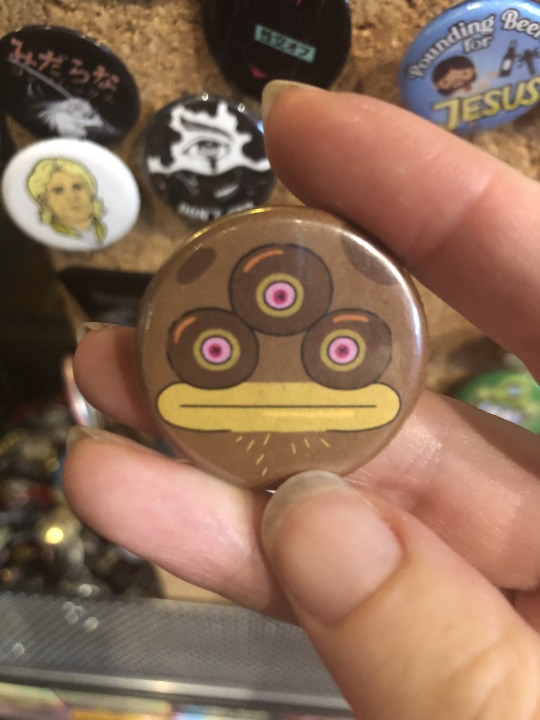
These blankets aren't new, but I realized for the first time that they're reversible! I guess I wasn't paying attention to the label. They're actually pretty soft and cozy.
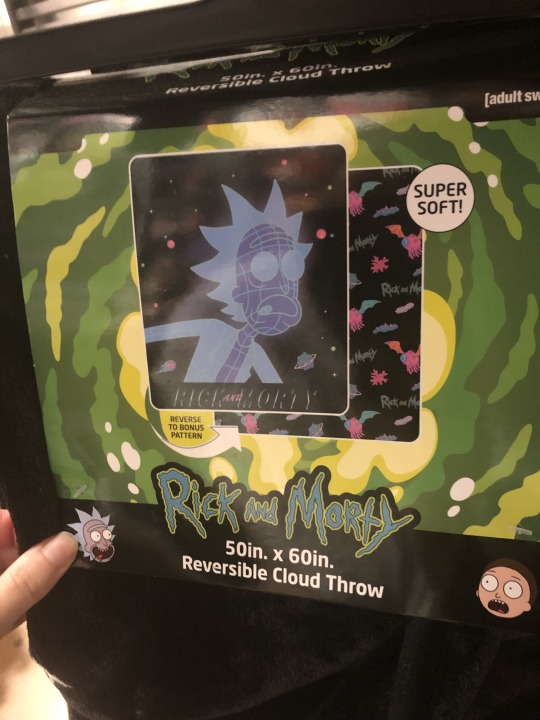


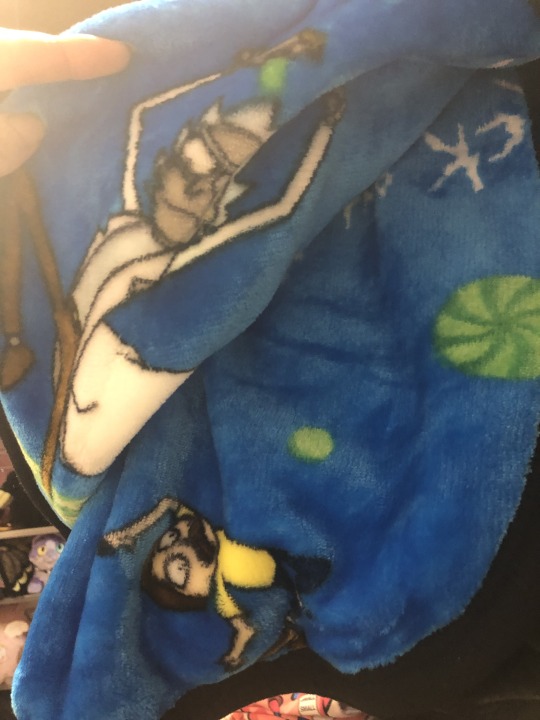
Today, I went to the mall closer to my area. Rue 21 is always stocked with Rick and Morty apparel, but they haven't had new designs in a while--maybe one new item at most. But today, I was delighted to walk in and find new merchandise!
Sweatpants! That's quite the pose Rick has there. But that's how we watch Rick and Morty, right? Giggling and kicking our feet?

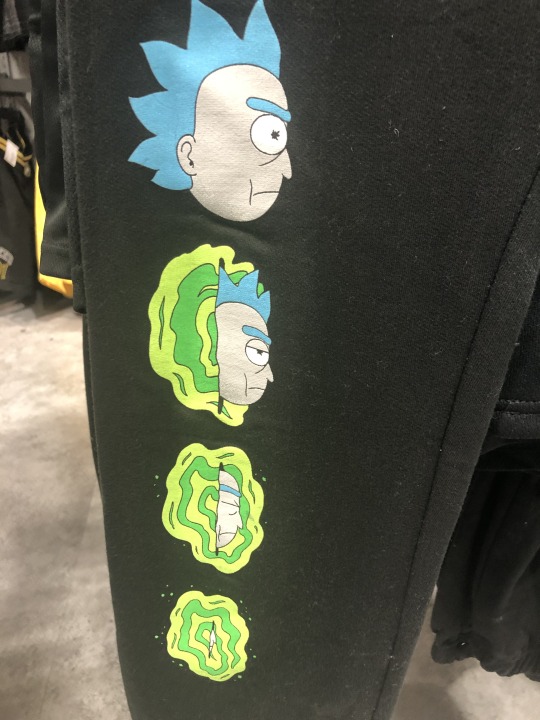
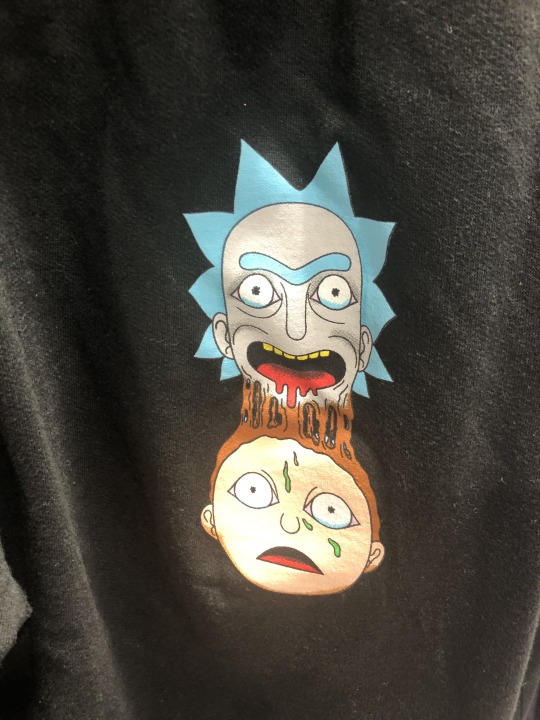
A new jersey! It's well-designed, but I still don't understand why the artists put the vat of acid on merchandise. It's cursed!

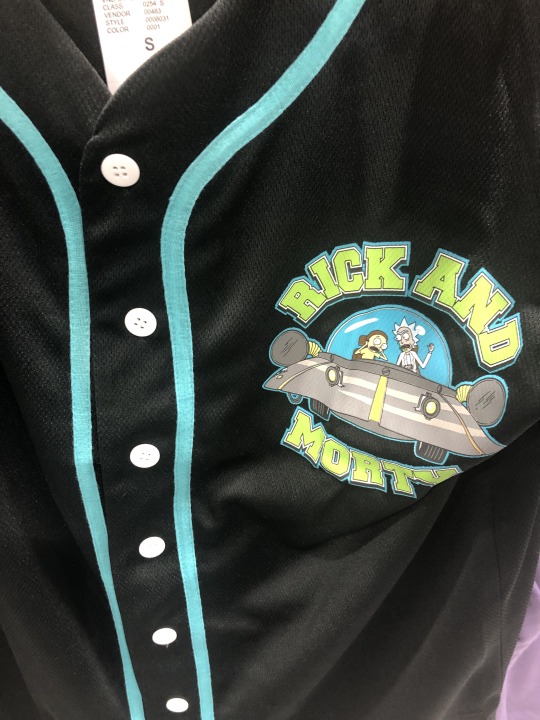

I turned around to find...shorts! Finally, apparel where Rick and Morty are happy for a change.


More shorts, this time with a science theme. "Rick and Morty Forever and Ever." Rick's laughing face is charming. Apparently, a lot of people like Rick's laugh, to the point that they make TikTok compilations? Honestly, I think his laugh is a little grating, but his expression is cute.

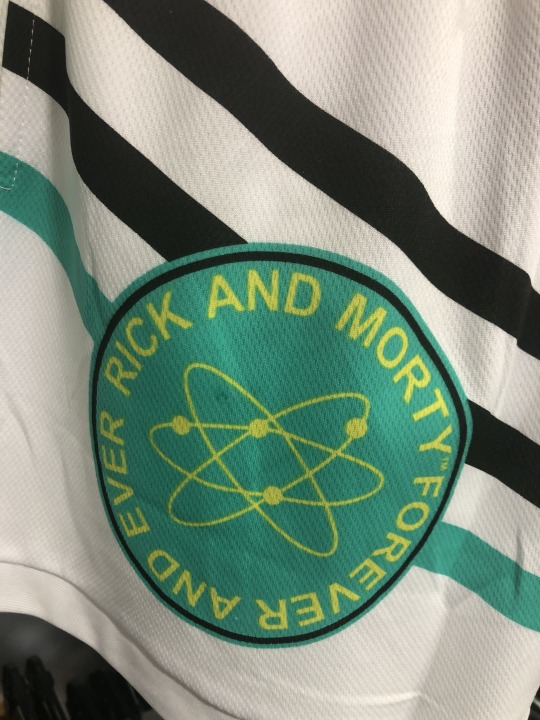
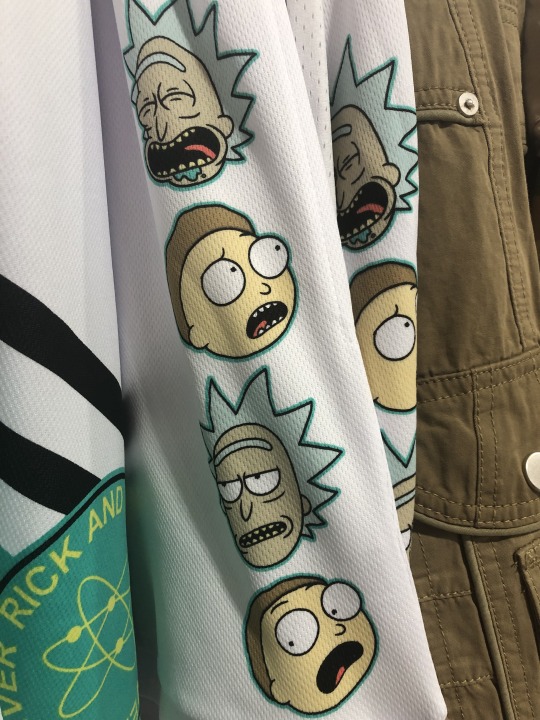
New T-shirt! As always, Morty screams.

I love this shirt's retro design. The colors are well-balanced.

Hot Topic didn't have anything new, but a customer did compliment my Miss Minutes shirt. I could do a Loki merchandise roundup with the items I see in Hot Topic and "nerdy" stores, but I don't think people follow me for him 🤔
Afterward, it was time to head to Spencer's. Someone thought it'd be cool to set off one of the screaming chickens, but I didn't let it distract me from the new merchandise even as the drone echoed through the store. I guess the employees get used to people setting shit off all day.
New keychain!
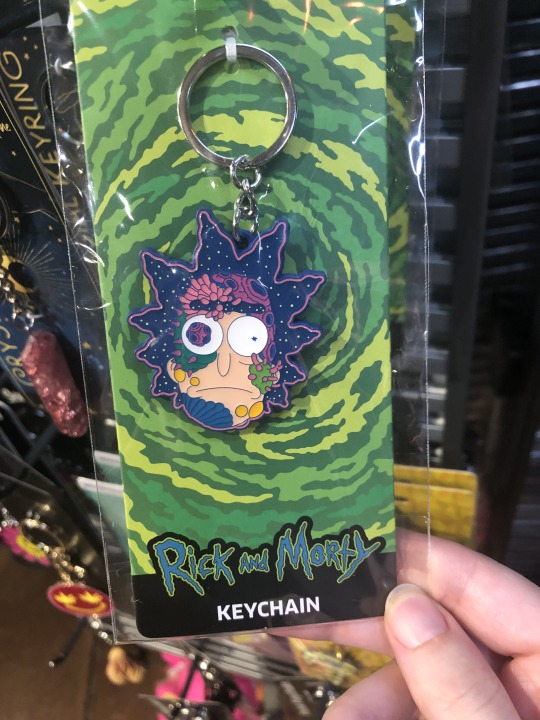
Belts!
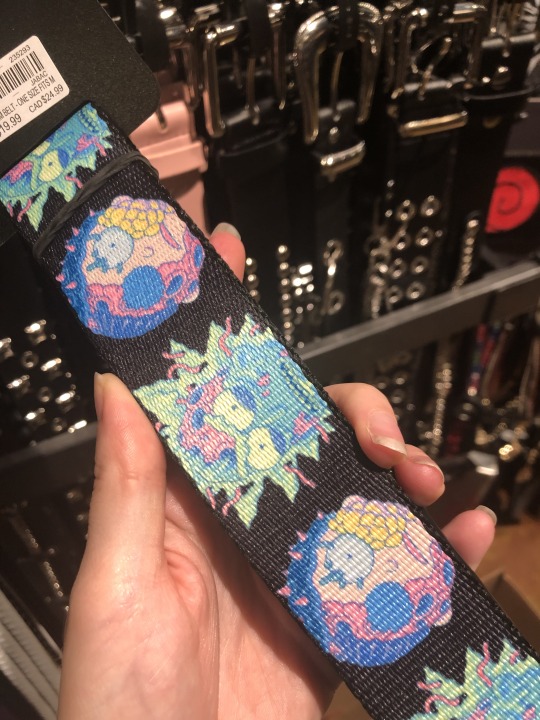

As always, Pickle Rick and the Rick and Morty cube (as another customer put it) were there to greet me. Pickle Rick looks happy, but did I intimidate Morty? He screams in terror!

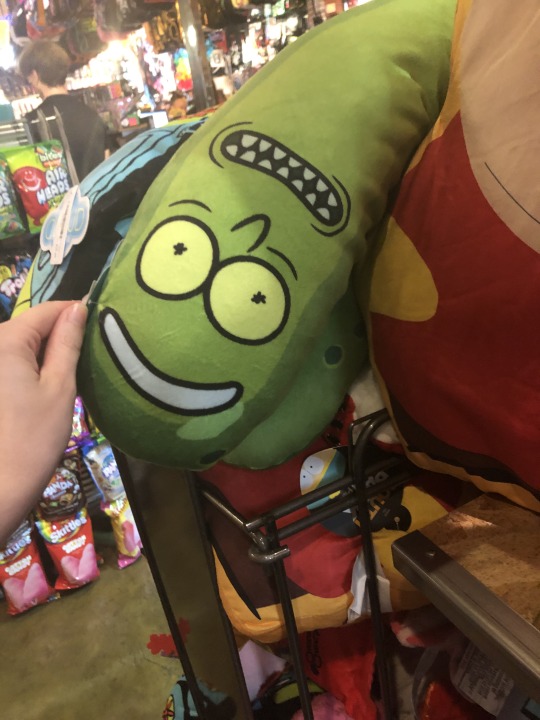
Unrelated, but I saw this shirt in another store and thought it was funny.

Sage advice!
45 notes
·
View notes
Note
The logo on Steve's trousers is quicksilver I had no idea if it was a surfer brand but its generally sold in sporting apparel stores but the Internet says:
'Born on the beach, Quiksilver's core concept of fashion with function has now been embraced by all who enjoy active outdoor lifestyles. The cresting wave and snow capped mountain logo symbolises excellence and authenticity. The logo was inspired by a famous Japanese woodcut depicting a typhoon wave and Mt Fuji.' - quicksilver brand website
'Quiksilver is an American brand of surf-inspired apparel and accessories that was founded in 1969 in Torquay, Victoria, but is now based in Huntington Beach, California. It is one of the world's largest brands of surfwear and boardsport-related equipment.' - Wikipedia
woah thank you!!! i've never heard of this brand but thats really cool!!
I still cant tell if they're the ones he wears in the actual scenes but i found these online and they look pretty similar in terms of fabric weight wise so maybe the ones in the jk picture are what he wears!!!
i just love fashion so its fun to have a new brand!!! exiting!!! ty so so much anon!!!
6 notes
·
View notes
Note
for the asks!
23. favourite piece of clothing?
ohh this is a tough one bc i have a few comfort items and stuff. its mostly jewelry that has the most sentimental value
my favorite shirt is either a prince muscle tank my dad gave me that he used to have, or a def leppard shirt from when i saw them in concert (the shirt i’ve been wearing nonstop is from my friend ezra who runs pussyboy apparel)
favorite pants are camo cargo pants i got from a free trans closet at a pride event. i’ve got a few patches i’ve put on there from queer artists
shoes have to be my platform docs (but i’m mad at them right now because the sole split randomly on a trip and i had to fix it) and also i found some vans for six bucks at a thrift store and i went to town on them with a magic eraser and cleaned the laces too. so they’re fun
but RIGHT NOW my favorite piece of clothing to wear out and about is my keffiyeh! first of all its fun to style, but the recognition from other people feels idk powerful. we walk past a lot of strangers whose lives we don’t know but when i see other people wearing theirs, or they smile or compliment it or ask how to pronounce the name of my scarf— it makes me feel more connected outside of online activism as well
soft asks :)
2 notes
·
View notes
Text
Flying Minds - The Defunct Cyberchase Merch Empire (part 1)
So, I fell down a bit of a rabbit hole recently. I started looking into a long-defunct company called Flying Minds that had an association with Cyberchase. It all started when I was looking at my DVD of Ecohaven CSE and found this.

Calling all Cyberchase fans... For your exclusive Cyberchase download, check out www.flyingminds.com
Limited Time offer!
Promo Code VID05
There were some free downloadable items available on the actual pbskids.org website back in the day. There were a few downloadable flash-based screensavers and a calculator voiced by Bianca. These have been preserved on the Flashpoint Archive. However, I have no idea what this exclusive download from flyingminds.com would have been. I would be very curious if it was still circulating today. Unfortunately, it seems very unlikely that it would have been preserved by WayBack Machine archives, since you needed to put in a promotional code to get it.
Regardless, I started looking into the archives of the flyingminds website to see what they had to do with Cyberchase. It turned out that they sold a bunch of Cyberchase-branded products back in the day. Before I get to that though, I figure I should set the scene for what Cyberchase merch looks like today. Here is the official PBS kids store.

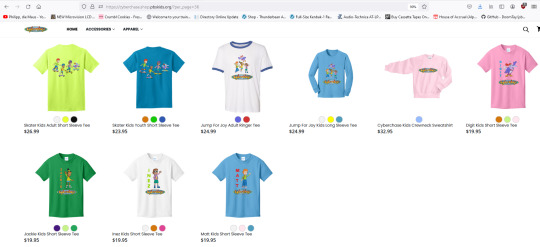
It's mostly clothing. We can see shirts, hoodies, baseball caps, and a tote bag. We can see some stuff themed after the 20th anniversary of the show, while other stuff is more generic. I've seen the exact same catalogue on a site called merchmake, so perhaps this is who the current show-runners contracted the merch out to.
I also found some more baggage on a site called personalized planet. While this isn't the official PBS Kids store, I'm pretty sure this is legitimate.

I'm only including stuff that I believe is official. I'm not talking about Etsy here, since that tends to be unofficial fan-works. I'm also not talking about Redbubble, since its so infamous for art theft.
So, that's about it for official Cyberchase merch in the present day. There's not very much of it. However, if wind the clock back to 2005 when Flying Minds was active, things were very different. They had a partnership with Thirteen/WNET New York to bring out a much wider variety of Cyberchase merchandise. Let me show you through Wayback Machine archives. Unfortunately, much of their catalog photos were not archived, but I'll see what I can do to supplement. I think the best place to start here is with Flying Minds's own explanation as to what they were doing with Cyberchase.

Begin
What is Flying Minds? Established in October 2004, Flying Minds is a partnership between C&T Ventures and Thirteen/WNET New York working together to bring you cool, innovative products that will engage your children in a world of fun learning. Flying Minds has teamed up with Thirteen/WNET's acclaimed children's program, Cyberchase, to be your online store for Cyberchase gear, including school supplies, apparel, games and toys. As co-producer of this award-winning show, we are very proud to be a part of the Cyberchase family and will continue to work closely with the creators of the program to bring you exclusive products for many years to come.
In keeping with our mission to provide "Cool Stuff for Clever Kids" (and adults too), Flying Minds is committed to making your visit to our site an enjoyable experience. To this end, we will continue to develop and seek out quality products, activities and services (both fun and educational) that meet our demanding standards. Whether through information to help kids learn about financial literacy or a loyalty program where kids and adults can spend or save points, our goal is to grow Flying Minds into a company that provides an interactive and entertaining experience for our customers.
Most importantly, your purchases at www.flyingminds.com help to support Cyberchase and Public Television. For cool activities and to learn more about Cyberchase, visit www.pbskidsgo.org/Cyberchase/.
End
Most archives I have found of the site are from 2005. Unfortunately, it seems that Flying Minds didn't last very long after all. I know that some of their Cyberchase products are considered collector's items now, and they can get expensive.
Their most famous product is the sole official Cyberchase plush toy, Digit. He's my co-producer for this Tumblr blog.

Let's see what we can gather from the remnants of their site.
The first section on the list is "School Supplies" This was originally two pages, but it seems like only the first page of this section was archived at all. Even then, the pictures from the first page have not been saved.
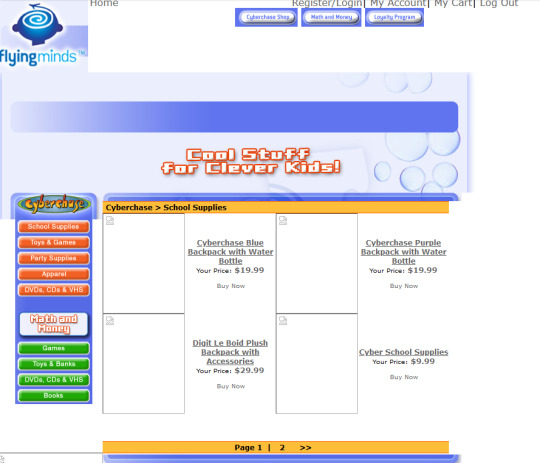
Just to be clear, the Digit plush that I have is not a backpack. I have only ever seen one size of this plush, so the listing for a "Digit Le Boid Plush Backpack with Accessories" is a bit confusing to me. I haven't seen any vintage Cyberchase backpacks or water bottles floating around either.
I did see a Worthpoint listing for a prior eBay sale of a pencil case, mechanical pencil, and stickers. The pencil case had Flying Minds branding on the back, so it looks like we can fill in that blank. It may have been part of the prizes for either the 2004 or 2005 Cyberchase Online Contests as well.


The next section to look at is the "Toys & Games" section. Once again, only the first page has been archived at all, and all of the images are missing.

So, they talk about a clock with a stop watch, which they also refer to as a keychain. I haven't seen this exact item, but I have seen a Worthpoint listing for another vintage Cyberchase keychain.
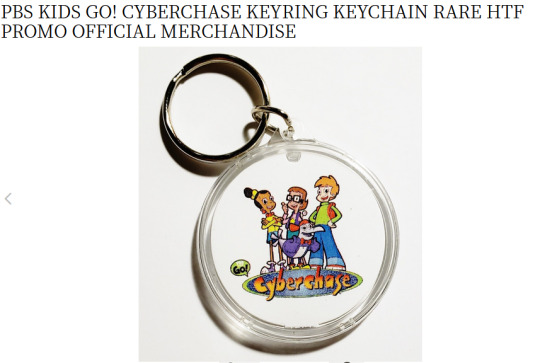
I also found a Worthpoint listing for that collector tin with 2 packs of playing cards, so we can document that.
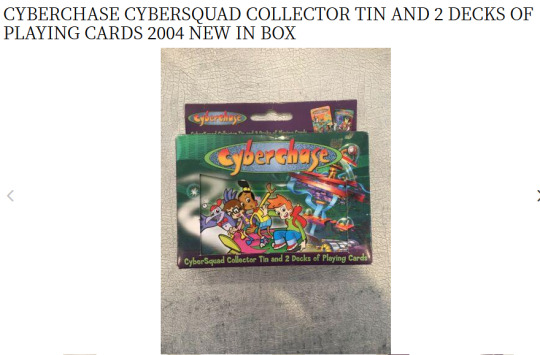
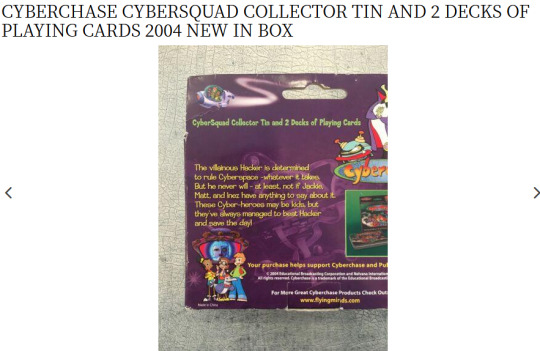

We've already talked about the famous Digit plush. I haven't seen any pictures of the "Super Cyber 100-Piece Floor Puzzle".
Next, we can look at the "Party Supplies" section. There are only two items in here.

I was able to source a picture from pintrest showing an eBay listing for some Cyberchase party supplies. I assume these are the same ones that were sold through Flying Minds, as it was listed as a party set for 8.
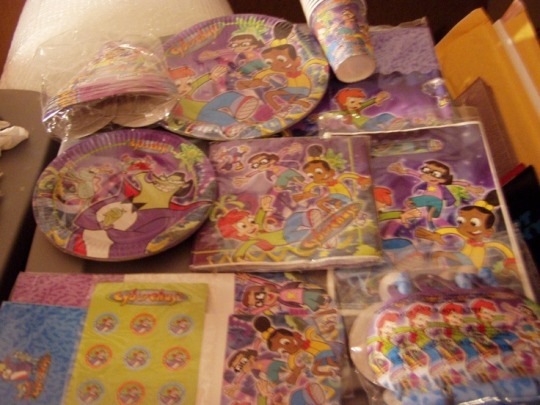
I can see napkins, stickers, plates, cups, and hats. I think I also see placemats (middle right), cards (bottom middle), wrapping paper (top right), and some sort of cardboard hanging decorations (bottom right).
Next, we can move on to the "Apparel" section. This is yet another section where only the first page was captured and the images were lost.
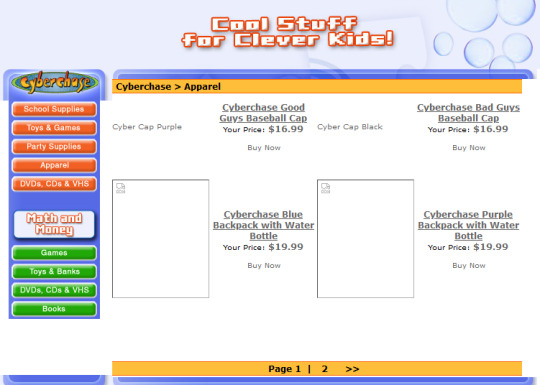
Once again, we have those backpacks that I wasn't able to source. photos for. However, I was able to source photos from an eBay listing for the "Cyberchase Bad Guys Baseball Cap"



Next, we get to look at the "DVDs, CDs, and VHS" section. Unfortunately, this section's original proud 4 pages have been cut down to a single page of entries with their pictures missing.

Thankfully, these four DVDs are pretty well-circulated these days, so they aren't mysterious.

The other half of site is marked as "Math and Money". However, it is a mixture of items that are branded Cyberchase and items that are not branded as Cyberchase, so I will go through them.
First, we have "Math and Money - Games".
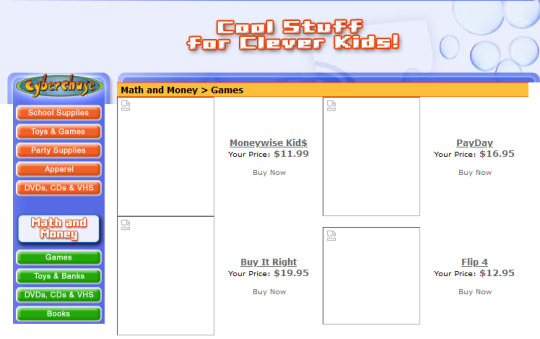
I actually figured out what "Moneywise Kid$" is, as the website for the developer, Strom Mfg., showcases the box.

PayDay was a money-management board game that was originally released in 1974. With that in mind, I believe that Flying Minds would have been selling the 30th anniversary edition in 2004-2005.

"Buy It RIght" was probably this board game version from 2002.
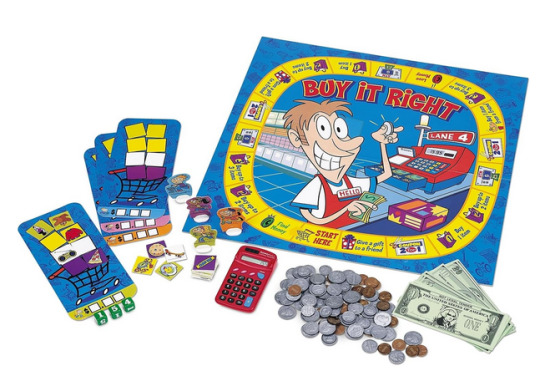
This was probably what they were talking about with "Flip 4".
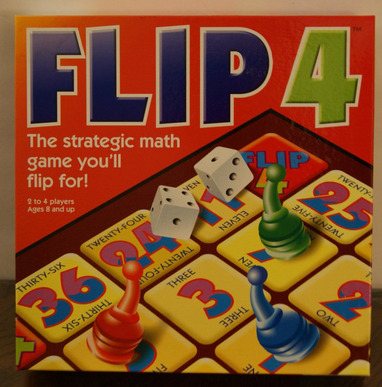
We can move on to "Toys & Banks". Unfrotunately, I don't think contains the amazing bank that Slider assembled for "The Snelfu Snafu"

I was able to find the Moonjar Classic Moneybox on Moonjar's website.

The other items have such generic names that I won't be able to provide a definite answer.
Continued in part 2, as I hit the image limit.
4 notes
·
View notes
Text
Embrace Pure Wonder with Dina Nashman!

Hey Edmontonians! - We're thrilled to introduce Pure Wonder, founded by the visionary Dina Nashman, your go-to destination for eco-friendly and stylish apparel right here in our beautiful city!
Dive into sustainable fashion with our Organic Cotton Collection – crafted with love and care for both you and the environment.
Tote-ally Chic: Say goodbye to single-use plastics and hello to our versatile and durable cotton tote bags! Perfect for shopping, strolling, or just slinging over your shoulder with pride.
Snuggle up in Style: Unwind in our comfy and cozy cotton sweatshirts, designed for those chilly Edmonton evenings. Fashion meets comfort – a match made in Pure Wonder heaven!
Hoodies that Hug Mother Earth: Elevate your street style with our trendy cotton hoodies, keeping you warm while keeping the planet cool. Because looking good and feeling good should go hand in hand!
Why Pure Wonder?
📷 Certified Organic Cotton
📷 Ethically Sourced
📷 Locally Made in Edmonton
📷 Environmentally Friendly Packaging
Dina Nashman, our Founder and CEO, is on a mission to redefine fashion by blending elegance with eco-consciousness. Stay tuned for our website launch, coming at the end of March to mid-April, where you can explore and shop the collection! 📷📷
Visit our store in Edmonton or join us online at www.purewonder.ca. 📷📷 Together, let's make fashion a force for good! 📷📷 #PureWonder #EdmontonFashion #SustainableStyle #OrganicCotton #FashionWithPurpose #DinaNashman #purewonder #pure wonder
2 notes
·
View notes
Note
Do you have a fave website or sites where you buy your clothes from? There’s straight up no brick n mortar places to buy from in the city I’m going to uni in
Incoming long-ass fashion post, sorry😂
If there's no thrift shops near you, I highly recommend Mercari, Depop, and Poshmark for secondhand, brand-name clothes. I don't usually shop for brands specifically, but some of the names I own and have heard of that might help you search are Killstar, Disturbia, Lip Service, Tripp, Midnight Hour, Foxblood, Blackwood Castle, Dracula Clothing, Phaze Clothing, Punkrave, Dark in Love, etc.
Of course many of these have their own active sites that you can buy from, but I'm a big fan of secondhand shopping over buying fast fashion outright!
Also, I wanna plug some of my local small businesses & friends that carry apparel you might be interested in:
(Given they're small businesses a lot of it's sold out, but Rumors updates daily!)
99% of my basics wardrobe comes from thrift stores or places like TJ Maxx, Marshalls, etc. I found that a lot of my clothes from thrift stores come from H&M and Uniqlo, which you can buy online or through the apps I mentioned. I pretty much only wear plain black clothes in textures I like and then I layer the hell out of it with cardigans, jackets, jewelry, and belts!
In terms of jewelry, I don't have a lot (UNFORTUNATELY...) but I much prefer buying jewelry, belts, and other accessories and layering them over otherwise "boring" all-black outfits. I like Etah Love, Regal Rose, Tommy Vowles, Remains Jewelry, Raspberry Mazohyst, and secondhand Killstar and Punkrave. Some of my favorite pieces (like rosaries and vintage) come from antique stores, Ebay, and Facebook Marketplace. I also make my own necklaces from chain you can buy at Home Depot (you can probably buy chain on places like Amazon too). A plain black T shirt or band shirt paired with some rings or a chunky necklace is my go-to for everyday wear!
Speaking of, band shirts are pretty much the best thing ever. Bandcamp and Instagram are great resources for this and it's a win-win-win. In buying a shirt you support the artist, discover new music, AND you get to look cool hahaha
For shoes (my favorite and imo the most important element), I like Poison MX, New Rock, Gothic Shoe Company (defunct), Goth Pikes (defunct), Demonia, TUK, Fluevog, Underground, and secondhand H&M and Forever 21.
Last thing on clothes is that DIY is, besides buying merch from smaller bands, the best way to own pieces that are unique to you and your style. There's loads of tutorials out there, I like making patches with cheap paint and sewing them onto whatever, adding spikes/chains, and cutting up shirts and jeans to change the fit and make them more interesting visually. The possibilities are endless. In high school when I couldn't afford band shirts, I'd just make my own!
There's LOADS of threads on Reddit as well with links to clothing stores, I also like to see what pages my favorite jewelry/clothing shops follow on Instagram to see what else is out there!
I hope some of this helps you out, I went to a small town college myself and it's rough trying to figure out your style when there's nothing around in person to get inspired.
#ask#SORRY THIS IS SO LONG!!!#im passionate....#but i hope some of this is useful to u#ive only very recently started buying clothes online cuz i have weird measurements loll but theres so much good stuff out there
16 notes
·
View notes
Text





















essories naturally evolved to fulfill necessities, while others were introduced to represent social status and wealth. Early accessories — when humans were dancing around a fire dressed in leaves and animal skin — were made of bones, seeds, feathers, shells, and stones. Crowns, amulets, or badges often depicted the status of the individual in the tribe or town.
Necessity carved the other sets of accessories, such as bags and footwear. Glasses, shades, and watches (often replaced with Fitbit these days) were introduced to the list with newer inventions.
In the last few centuries, it has been observed that wars and economic depressions have impacted fashion more than any major brand or designer. For instance, in the Victorian era, gloves, fans, and extravagant hats were integral to women’s wear, while after the Great Depression, the style became subtle and minimalist with long socks and simple hats.
Accessories are capable of changing the mood of a get-up. Social media is filled with tutorials to style the same dress for different occasions by just changing the accompanying accessories — just changing how a scarf is worn or adding a belt can change the whole vibe of the look.
National Accessory Day timeline
150,000 Years Ago The Most Vintage Necklace
Archeologists find a 150,000-year-old necklace made of perforated beads and seashells at an excavation site in Morocco.
20th CenturyThe Term “Fashion Accessory” Originates
The term ‘‘fashion accessory’ comes into use, attributed to the adornments worn to compliment the main attire.
1837 Hermès is Established
Hermès, the oldest French luxury house that continues to be operational today, is founded.
1995 The Advent of Internet
With the advances in the internet and online transactions, clothes and accessories are sold online, with eBay being one of the first online stores in 1995.
National Accessory Day FAQs
What do accessories do to an outfit?
If you’re tired of your wardrobe, you can switch it up by not emptying your pockets. Some classic additions can breathe new life into your wardrobe.
Which designer bag is the most expensive?
The Guinness World Book of Records notes the most expensive bag to be the 1001 Nights Diamond Purse from the House of Mouawad. It took 8,800 person-hours and 10 artisans to make.
What is the most popular item of jewelry?
Earrings are considered the most popular jewelry among women.
National Accessory Day Activities
Spice it up
Make your own accessories
Spread the love on social media
Rather than picking an attire and styling it with accessories, spice it up a little today and pick some accessories and choose an outfit to match it. You can look up styling tutorials online and experiment with different looks.
Do you remember buying colorful beads and weaving them into a necklace? Well, you can do the same or find something more exquisite to make jewelry with, such as feathers, pearls, silver beads, or flowers.
Tell fellow aficionados about National Accessory Day. Share your love on social media by sharing a picture of yourself in your favorite accessory.
5 Interesting Facts About Accessories
16 love charms
30% of e-commerce
Accessories as a symbol of strength
Symbolism of status
The founder of National Accessory Day
In Hindu culture, married women wear 16 adornments called ‘solah shringarm,’ as a symbol of prosperity.
In the U.S., the apparel and accessories industries account for 30% of the e-commerce business.
Villages in the older period thrived on the prowess of hunters; hence, they wore the teeth and bones of the fearsome animals that they had killed.
Accessories such as amulets, rings, and necklaces often symbolized the social status of individuals in ancient societies.
National Accessory Day was founded by Luxury Next Season in 2019.
Why We Love National Accessory Day
It gives a whole new vibe
This day celebrates fashion
It celebrates art and luxury
Accessories give a new vibe to ordinary outfits and totally transform the look. The hoop earrings are for the days when one doesn’t want to put in an effort. The bold ring with a suit gives the vibe of a classy bad boy.
National Accessory Day gives us an occasion to celebrate the indomitable element of fashion. Fashion is a form of expression worthy of celebration, and this is the perfect day to show our appreciation.
Diamond-studded bags and gold watches are some of the most expensive accessories in the world. Owing to their rich history, vintage accessories are also very expensive owing to their rich history. As accessories are symbols of many things, this day celebrates art, luxury, and history.
Source
#California#Napa Valley#indoors#outdoors#original photography#summer 2023#travel#vacation#USA#tourist attraction#landmark#National Accessory Day#3 November#NationalAccessoryDay#Canada#professional portrait#Yukon#British Columbia#Alberta#Oregon#Jasper National Park#Bend
2 notes
·
View notes
Text
It's Working Out
We have spent a lot of time of late discussing the disruptors, the upstart firms that upset the apple cart of people’s comfort. They challenged old ways of doing things, introducing new ways and means of meeting consumer needs and wants. They are the innovators.
But perhaps the greatest disruptor of our time was not an innovator at all, but merely a force that set the stage upon which everyone, from person to firm, had to react. Some were able to, while others were not. Some were willing to, while others were not.
That force of course, was COVID, which pushed us all to the brink. Here we are, three and a half years since it brought the world to its knees. Narrowing our focus to only companies, we can categorize them today as having thrived, survived, or died. Often there was no rhyme or reason, as some firms were simply in a good place at a bad time.
But even if they were in either of the first two categories, there was and is no guarantee now that success would be theirs. The big disruption is over, and it is back to doing business much the same as it was before, but with evolutionary twists and turns along the way.
Take, for example, Peloton and Lululemon, two companies that thrived during COVID, and are now forging a partnership. Seemingly complementary (although as we shall see, also competitors), it made sense that fitness hardware would enjoy the company of fitness apparel. After all, we were working from home, and doing pretty much everything there. Sales of Peloton stationary bikes soared. Sales of Lululemon clothing did likewise. Hand, meet glove.

But that’s where the comparison abruptly ends. Homes only need one stationary bike, and at $2500 for a typical model, plus another $45 a month for the workout subscription service, it became an expensive proposition. Once we started returning to more normal life, Peloton sales plummeted, and they were bloated with unsold inventory.
Lululemon, though, continued the trend line of the pandemic, thanks in large part to the broader fashion statement of athleisure apparel. In other words, while you can’t take your stationary bike with you out of the house, it is fine indeed to wear yoga pants wherever you go. Apples, meet oranges.
It must be noted that Peloton and Lululemon were not exactly best buddies through all of this. While Peloton had its own in-house line of fitness apparel that competed with Lululemon, it was Lululemon’s acquisition of Mirror in June 2020 that sparked controversy. The $995 and up hardware device offered users fitness routines while narcissistically looking into a huge reflective object. Lululemon accused Peloton of pilfering workout routines to sell via its subscription service. It wound up in court; the two firms settled last year.
Lululemon did not enjoy success with Mirror; it wound up writing off the acquisition, which had cost them $500 million. While clothing sales have been brisk, Mirror was a thorn in their side. Meanwhile, Peloton has struggled mightily the last couple of years, its stock price tracking like an asteroid to earth. Thankfully, new leadership of late has seen fit to break away from the COVID business model, exploring new partnerships and distribution channels.
For example, Peloton inked a deal with Hilton, and now a Peloton bike appears in every hotel under the Hilton umbrella. That’s genius, because it allows for risk-free product trial. They also partnered with Amazon and Dick’s Sporting Goods for online and in-store sales and distribution. How silly it was of Peloton to think it could survive long-term doing all of its selling. Furthermore, they have realized that, while hardware is a necessary component in their future, it is the subscription service that is the cash cow that can keep giving.
The new partnership between the two means that Lululemon will produce all Peloton-branded exercise apparel. Lululemon also agreed to cease production of its Mirror-related. Two COVID success stories who found themselves enemies have effectively kissed and made up.
And I am betting that both will thrive under this new arrangement and their other related corporate decisions. While I have no experience with Lululemon products nor Peloton, I secretly wish for the latter to rebound, if only because I own a lot of other fitness hardware. But I also know that you have to actually use that hardware, and equipment from stationary bikes to treadmills and weight benches often wind up as expensive clothing racks at home.
Let this new marriage serve as example that there are always new ways to solve problems, which, in this case, were discovered in the post-COVID era. While both found themselves the darlings of the age, neither could sustain their businesses completely. Together, though, this might just work out.
Dr “Let’s Ride” Gerlich
Audio Blog
3 notes
·
View notes
Text
Coco Chanel:
Coco Chanel is well-known for her timeless designs, signature suits, and little black dresses. She developed her first perfume in the 1920s and later introduced the Chanel suit and the little black dress, with a focus on designing garments that were more comfortable for women. She became a fashion star recognised for her basic yet classy ensembles mixed with wonderful accessories, such as many strands of pearls. Gabrielle Bonheur Chanel was born on August 19, 1883, in Saumur, France. Her early years were far from glamorous. Chanel was placed in an orphanage by her father, a peddler, when she was 12 years old, following the death of her mother. Chanel was reared by nuns who taught her how to sew, which led to her life's profession. Her moniker stemmed from a very different job. During her brief singing career, Chanel was known as "Coco" at bars in Vichy and Moulins. Chanel met Etienne Balsan, who promised to help her establish a millinery company in Paris, when she was about 20 years old. She soon abandoned him in favour of one of his wealthy pals, Arthur "Boy" Capel. Both men played important roles in Chanel's first fashion endeavour. Chanel began selling hats in her first boutique on Paris's Rue Cambon in 1910. She then expanded her business to include stores in Deauville and Biarritz, as well as clothing manufacturing. On a chilly day, she fashioned a garment out of an old jersey for her first taste of fashion triumph. In response to the numerous inquiries about where she obtained the outfit, she volunteered to make one for them. "My wealth is founded on the old shirt I wore in Deauville because it was cold," she once told author Paul Morand. Chanel rose to prominence in the intellectual and artistic communities of Paris. She worked with Jean Cocteau and Pablo Picasso on garments for the Ballets Russes and his play Orphée.

youtube
In the 1920s, Chanel elevated her booming firm to new heights. She created her debut perfume, Chanel No. 5, which was the first to contain a designer’s name. Perfume “is the invisible, memorable, ultimate accessory of fashion. . . . that signals your entrance and prolongs your departure,” Chanel once remarked. The scent was in reality also sponsored by department store owner Théophile Bader and industrialists Pierre and Paul Wertheimer, with Chanel forging a strong acquaintance with Pierre. A agreement was subsequently arranged where the Wertheimer corporation would take in 70 percent of Chanel No. 5 earnings for making the perfume at their plants, with Bader receiving 20 percent and Chanel herself only receiving 10 percent. Over the years, with No. 5 being a significant source of cash, she continually sued to have the terms of the arrangement renegotiated. In 1925, Chanel designed the now renowned Chanel suit with collarless jacket and well-fitted skirt. Her designs were groundbreaking for the time—borrowing features of men’s apparel and prioritising comfort above the limits of then-popular trends. She helped ladies wave goodbye to the days of corsets and other restricting clothes.

youtube
This video gives a brief history of the french fashion designer Coco Chanel and her biography. It continues to go in more depth with experts and historians adding their own knowledge and details to the video allowing more information to be learnt. I choose this specific video as I like to listen to historians and experts views but also see the pictures and garments from the designer Coco Chanel.
Referencing:
Biography.com Editors. (2014). Coco Chanel Biography. [Online]. The Biography.com website. Last Updated: 10 December 2021. Available at: https://www.biography.com/fashion-designer/coco-chanel#:~:text=Who%20Was%20Coco%20Chanel%3F,were%20m [Accessed 11 December 2022].
2 notes
·
View notes
Text
https://drakemerch.co/ovo-drake/
0 notes
Text
Sports Jackets Mens
Founded with a passion for style and quality, Earch Apparel has grown to become a trusted name in the fashion industry. We believe that clothing is more than just a necessity & Our easy-to-navigate online store, and fast shipping are designed to make your shopping experience seamless and enjoyable.
Sports Jackets Mens

0 notes
Text
What’s Trending in Children’s Western Wear?
Parents who want to Little Stars Childrens Wear in something fashionable yet comfortable are increasingly choosing children's Western wear, which combines classic and modern styles. These standard pieces—from plaid shirts and fringed vests to denim jackets and cowboy boots—are getting a makeover through playful designs, vivid hues, and plush materials. Dresses through floral patterns, embroidery, and ruffles that are Western-inspired are also popular right now, giving girls a advanced yet fun look. Because comfort and adaptability are prioritized, youngsters may look fantastic and stay active in these items, which are ideal for special events as well as daily wear.
Fashionable Children's Outfits
Parents are becoming more picky about Children Fashion Dress, preferring designs that strike a balance between comfort and originality. The newest styles offer a wide range of possibilities, from sophisticated patterns to whimsical motifs, so every youngster may express their individuality via their wardrobe. There are many options available in Kiddies Clothing Stores, so it's simple to pick the ideal ensemble for every situation.
Different Styles for Young Children
Dresses for Littles are vital pieces of clothing for smaller kids. These dresses can be worn in a diversity of ways throughout the year, by options for short, long, and sleeveless sleeves. Parents and children alike find bright colors and playful patterns to be appealing, so they are general selections. These days, a lot of kid-friendly apparel retailers have collections that highlight these colorful looks, which makes browsing fun.
Why Organic Clothes Are Appealing
Stylish Organic Clothing more and more organic apparel as parents are suitable more aware of the materials their kids are wearing. Eco-friendly, maintainable fabrics that are kind to skin are used to make this attire. Trend-forward teenagers can now select from trendy designs that complement their ideals. Younger Organic Clothing for Teens also reflects the emphasis on sustainability, guaranteeing that the next generation can have access to solutions that are both ethical and fashionable.
Outfits for Littles for Any Occasion
Choosing the appropriate the Little Ones Clothingcan have a big impact on how they are dressed. There are many choices, even if it's for a playdate, birthday celebration, or family get-together. Coordinated sets that come by tops, bottoms, and accessories are now widely obtainable, making it simple to put together a whole ensemble. It's humble for parents to purchase children's clothing online, giving them access to a large variety without the trouble of going to several places.

Taking Up Western StylesAnother trend that is gaining traction is Children Western Dress. Kids are able to adopt a classic look with these dresses, which frequently have components like denim, plaid patterns, and whimsical decorations. Appearances inspired by the West are adaptable and can be worn to many different settings. Parents wishing to offer their kids with distinctive yet cozy clothing alternatives will find inordinate appeal in this trend.
In summary, the world of children's fashion is always changing, through new trends and styles appearing on an even basis. Every youngster can find something they love, ranging from outfits with Western influences to sustainable apparel. By utilizing the range of options found in Buy Kids Clothes Online, parents can make sure their children are always dressed to impress.
0 notes
Text
The Growing Appeal of Local T-Shirt Printing
Local T-shirt printing has seen a significant rise in popularity, fueled by the increasing demand for personalized, unique apparel. Whether for personal use, business branding, or community events, custom T-shirts offer an affordable and effective way to make a statement. The growth of local T-shirt printing businesses reflects the broader trend toward supporting local enterprises and the desire for more sustainable, eco-friendly options.
The Appeal of Customization
One of the primary reasons for the surge in local T-shirt printing is the desire for customization. Customers can create designs that reflect their personal style, group identity, or brand message. Unlike mass-produced T-shirts found in retail stores, custom shirts allow for a more personalized touch, from choosing the fabric and color to selecting a unique design or slogan. This level of customization appeals to a wide audience, including individuals, businesses, schools, and non-profits.

Supporting Local Businesses
Supporting t - shirt printing company has become a priority for many consumers who prefer to contribute to the local economy. These businesses often offer a level of service and attention to detail those larger companies cannot match. Additionally, local printers are more likely to source materials from nearby suppliers, further benefiting the local economy. By choosing a local printer, customers also enjoy quicker turnaround times and the opportunity to collaborate closely with designers to achieve the perfect result.
Eco-Friendly and Sustainable Practices
Another significant trend driving the popularity of local T-shirt printing is the growing awareness of environmental issues. Many local printers have adopted eco-friendly practices, such as using water-based inks, organic cotton, and recycled materials. These sustainable options appeal to environmentally conscious consumers who want to reduce their carbon footprint. Moreover, by producing T-shirts locally, there is less need for long-distance shipping, which reduces greenhouse gas emissions.
Technology and Innovation
Advancements in printing technology have also played a crucial role in the growth of local T-shirt printing. Modern techniques, such as direct-to-garment (DTG) printing and screen printing, allow for high-quality, durable designs that can be produced quickly and affordably. These technologies have made it easier for small businesses to enter the market and compete with larger companies. Additionally, online platforms enable customers to design their T-shirts digitally and place orders with local printers, making the process more accessible and convenient.
Community Engagement and Identity
Local T-shirt printing also fosters community engagement. Custom T-shirts are often used to promote local events, sports teams, and social causes, helping to strengthen community identity and solidarity. For businesses, branded T-shirts serve as effective marketing tools, increasing brand visibility and creating a sense of unity among employees and customers alike.
Conclusion
Best t shirt printing company reflects a broader trend toward personalization, sustainability, and support for local businesses. As technology continues to advance and consumer preferences evolve, the demand for custom T-shirts is likely to grow, offering exciting opportunities for both consumers and local printing businesses.
#cheap t shirt printing#custom screen printing#customized t shirts near me#custom t shirt printing#local t shirt print shops#logo printed t-shirts#order custom t shirts#t shirt print shop near me
0 notes
Text
Fanatics: Revolutionizing the World of Sports Merchandise
In the world of sports, fans don’t just support their favorite teams — they live and breathe their passion, and nothing represents that devotion more than the merchandise they proudly wear and display. Fanatics, a global leader in sports merchandise, has transformed the way fans connect with their favorite teams and athletes, becoming a powerhouse in the sports retail industry.
The Rise of Fanatics
Founded in 1995 by brothers Alan and Mitchell Trager, Fanatics started as a small brick-and-mortar retail business in Jacksonville, Florida. Initially, the company sold team-licensed sports apparel locally. However, the Tragers recognized the potential for growth in the e-commerce space and pivoted to online sales, a move that would set the stage for Fanatics’ meteoric rise.
In 2011, Fanatics caught the attention of e-commerce entrepreneur Michael Rubin, who acquired the company and merged it with his online retail empire, GSI Commerce. Rubin’s vision for Fanatics was clear: to create a one-stop shop for all things sports merchandise, where fans could find high-quality, officially licensed products for every major league and team in the world.
A New Era in Sports Merchandising
Under Rubin’s leadership, Fanatics rapidly expanded its reach and influence. The company secured exclusive licensing deals with major sports leagues, including the NFL, NBA, MLB, NHL, and NCAA, as well as with top soccer clubs and international sporting events. These partnerships allowed Fanatics to offer a vast and diverse range of products, from jerseys and hats to memorabilia and collectibles.
One of Fanatics’ most significant innovations was its vertical commerce model, which integrates manufacturing, marketing, and distribution. This approach enables the company to respond quickly to market trends and produce merchandise that aligns with real-time events, such as a player’s breakout performance or a team’s championship win. This agility has been a game-changer in the industry, allowing Fanatics to capture the excitement of the moment and deliver it directly to fans.
The Fanatics Experience
What sets Fanatics apart is not just its extensive product range but also the personalized experience it offers to fans. The company leverages data and technology to understand customer preferences, ensuring that fans can find exactly what they’re looking for, whether it’s a classic team jersey or a limited-edition collectible. Fanatics also offers customizable products, allowing fans to personalize their gear with their names or favorite player numbers.
Moreover, Fanatics has embraced omnichannel retailing, creating a seamless shopping experience across its online platforms, mobile apps, and physical stores. This strategy ensures that fans can shop for their favorite merchandise wherever and whenever they want, with fast and reliable delivery options.
Expanding Beyond Merchandise
Fanatics’ ambitions go beyond just selling sports apparel. The company has diversified its offerings to include digital products and experiences. In 2021, Fanatics launched Candy Digital, a subsidiary focused on digital collectibles and NFTs (non-fungible tokens), marking the company’s entry into the growing world of blockchain technology and sports memorabilia.
Fanatics has also made significant investments in sports betting, further integrating itself into the fan experience. By combining merchandise, digital collectibles, and sports betting, Fanatics is positioning itself as a comprehensive hub for sports enthusiasts.
The Future of Fanatics
With its innovative approach to sports merchandising and a commitment to enhancing the fan experience, Fanatics shows no signs of slowing down. The company continues to expand globally, entering new markets and forming strategic partnerships with teams and leagues around the world.
Fanatics’ impact on the sports industry is profound. It has redefined what it means to be a fan in the modern era, providing enthusiasts with more ways to connect with their favorite teams and players. As Fanatics continues to evolve, it remains at the forefront of the sports retail industry, shaping the future of fan engagement.
A Fan-Centric Revolution
Fanatics has revolutionized the world of sports merchandise by putting fans at the center of its business model. From its humble beginnings to becoming a global leader, Fanatics has always been driven by a passion for sports and a commitment to delivering the best possible experience to fans. As the company continues to innovate and expand, it will undoubtedly remain a key player in the sports industry, connecting fans with the teams they love in new and exciting ways.
0 notes